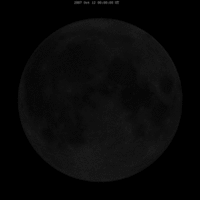- Lunar month
-
 Animation of the Moon as it cycles through its phases, as seen from the Northern Hemisphere. The apparent wobbling of the Moon is known as libration.
Animation of the Moon as it cycles through its phases, as seen from the Northern Hemisphere. The apparent wobbling of the Moon is known as libration.
In lunar calendars, a lunar month is the time between two identical syzygies (new moons or full moons). There are many variations. In Middle-Eastern and European traditions, the month starts when the young crescent moon becomes first visible at evening after conjunction with the Sun one or two days before that evening (e.g., in the Islamic calendar). In ancient Egypt the lunar month began on the day when the moon could no longer be seen just before sunrise. Others use a reckoned moon (e.g., the Hebrew calendar), or use a tabular scheme (ecclesiastical lunar calendar). Yet others run from full moon to full moon. Calendars count integer days, so months may be 29 or 30 days in length, in some regular or irregular sequence. But all lunar months approximate the mean length of the synodic month of approximately 29.53059 days (29 days, 12 hours, 44 minutes and 3 seconds).
There are several different ways of expressing the lunar month.
- The draconic month or nodal month is the period in which the Moon returns to the same node of its orbit; the nodes are the two points where the Moon's orbit crosses the plane of the Earth's orbit. Its duration is about 27.21222 days on average.
- The tropical month is the time for the Moon to return to the same ecliptic longitude, i.e., measured from the equinox; it is slightly shorter than the sidereal month, 27.32158, because of precession of the equinoxes.
- The Moon's orbital period in a non-rotating frame of reference (which on average is equal to its rotation period) is about 27.32166 days (27 days, 7 hours, 43 minutes, 11.6 seconds). This is known as a sidereal month and is measured by observing how long it takes the Moon to pass a fixed star on the celestial sphere.
- An anomalistic month is the Moon's orbital period measured from perigee to perigee - the point in the Moon's orbit when it is closest to Earth. An anomalistic month is about 27.55455 days on average.
- A synodic month is 29.53059 days (29 days, 12 hours, 44 minutes, 2.8 seconds) and is measured from New Moon to New Moon. A New Moon is defined as occurring when the Moon has the same ecliptic longitude as the Sun, as seen from the center of the Earth: i.e., when the Sun, Moon and Earth are almost on one line. A synodic month is longer than a sidereal month because the Earth-Moon system is orbiting the Sun in the same direction as the Moon is orbiting the Earth. Therefore, the Sun appears to move with respect to the stars, and it takes about 2.2 days longer for the Moon to return to the apparent position of the Sun. The synodic month is the most common way of expressing the lunar cycle.
See also
- Month
- Table of lunar month correspondences
- Hebrew calendar
- Hindu calendar
- Tithi
- Vedic timekeeping
References
- Observer's handbook 1991, Editor Roy L. Bishop, The Royal Astronomical Society of Canada (p14)
Categories:- Units of time
- Calendars
Wikimedia Foundation. 2010.
